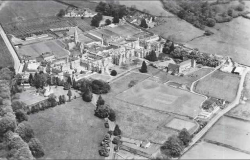Mendip Hospital
| Mendip Hospital | |
|---|---|
 | |
| Opened | 1848 |
| Closed | 1991 |
| Current Status | Preserved |
| Building Style | Corridor Plan |
| Architect(s) | George Gilbert Scott and William Bonython Moffat |
| Location | South Horrington |
| Alternate Names |
|
History
Now re-developed as a separate village & re-named 'South Horrington' utilising many of the former buildings as well as newly built homes, this was formerly the Mendip Hospital and its environs; a large psychiatric hospital built in Victorian times (1848 for 400 patients) to Sir Gilbert Scott's design. Initially, it served the whole of Somerset & Bath until the second wave of hospitals were built country wide around the turn of the 20th C. In Somerset's case, this led to the building of Tone Vale some 6 miles the other side of Taunton; of much more modest design and rather bland 'architecture'. Patients were transferred from the Mendip Hospital, which had long since exceeded its limit on the number of patients it was supposedly designed to cater for.
The frontage of the main Gilbert Scott building is indeed impressive, and fortunately listed, so it had to be incorporated into the conversion of the wards etc into flats, houses & apartments. It must be acknowledged that this whole development was carried out to a very much higher standard than perhaps some feared. The planned number of patients declined as the 1980s progressed - through a number of initiatives such as transferring some to residential & nursing homes, some younger people through a programme of learning (or re-learning) self-caring and daily living skills and then being placed in the community with varying degrees of support - from say simply home care through to a 24 hour staffed setting, and the changes in approach to treatment / therapy available which had not previously existed. Natural causes also played its inevitable part in reducing numbers, as well as strategies to avoid initial admission or having a considered discharge plan from initial admission.
By 1991, the hospital had been vacated and eventually sold to the developers; who retained the cricket pitch as a feature of village life. Currently, (March 2008), a multi-level care home is being built on the site of the demolished (bland, featureless, brick built) former Nurses Home, in the grounds close to the former farm. It was a classically self-sufficient hospital or 'asylum' (in its truest sense)- with a farm, gardens, church, laundry, bakery, butchery etc., etc., along with some staff accommodation on site. This was the model propounded by Jeremy Bentham et al following the passing of the Poor Law (Amendment) Act in 1834, with the notion of therapy provided by an 'asylum' tending to coincicide with the telling financial factors (of seeking self-suffiency and economies of scale). It also led to the 'out of sight, out of mind' phenomena, which often led to patients being effectively 'abandoned' by their family, and local communities avoiding that much contact with their close neighbours. As a result, even people living nearby often avoided any contact at all, which tended to give rise to all kinds of myths, unfounded fears and stigmatisation being associated with mental ill-health; themes which continue to resonate even up to the present time.
Cemetery
The Cemetery associated with the former hospital is situated along the valley towards Wells, and was reached by a hand cart route from the Bath Road alongside the Britannia Inn.


